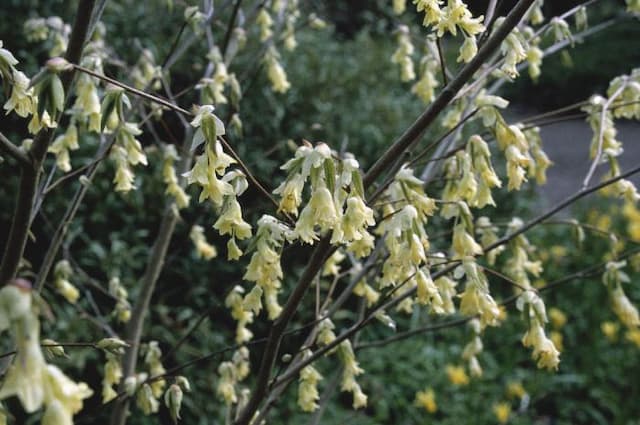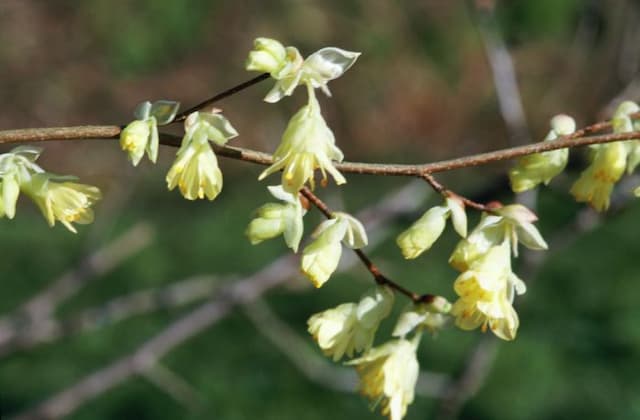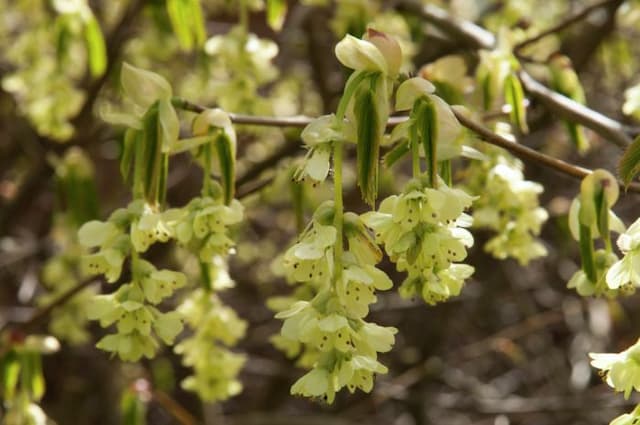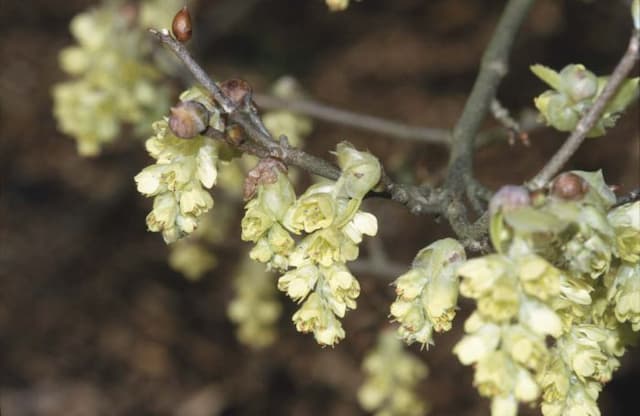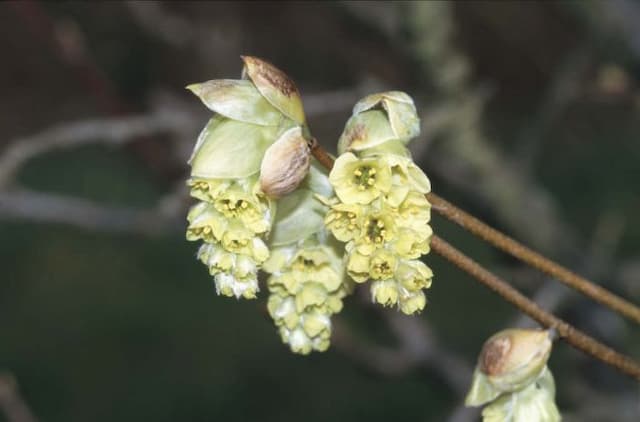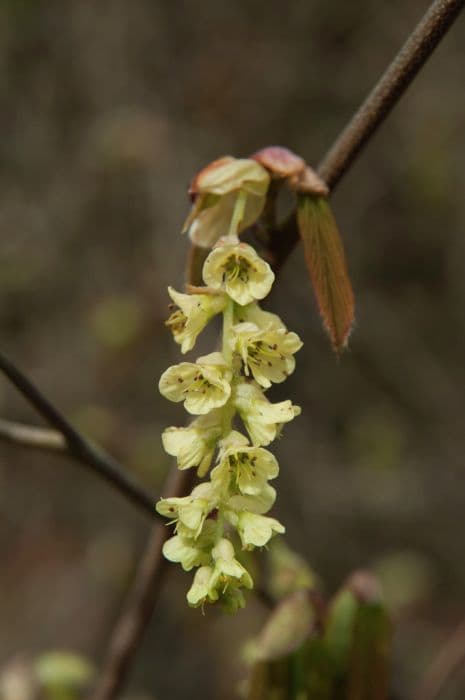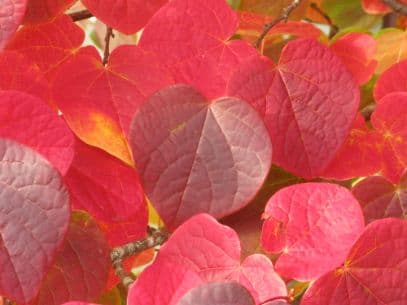Chinese Fringe Flower Loropetalum chinense var. rubrum 'Burgundy'

ABOUT
The plant commonly known as Chinese Fringe Flower 'Burgundy' features striking, deep burgundy to purple-red foliage that maintains its color throughout the growing season. The leaves are oval-shaped with a gently undulating margin, giving them an elegant appearance. Its most distinct attribute is arguably the vibrant pink flowers, which are strap-like and appear in clusters that resemble fringe or tassels. These blooms add a splash of soft color against the dark foliage and often emerge in late winter to early spring, creating a contrast that is visually striking to any observer. The overall growth habit of the Chinese Fringe Flower 'Burgundy' can be described as mounded or slightly arching, contributing to its ornamental appeal in landscape design.
About this plant
 Names
NamesFamily
Hamamelidaceae.
Synonyms
Chinese Fringe Flower, Red Chinese Fringe Flower, Chinese Witch Hazel, Red Loropetalum, Burgundy Loropetalum.
Common names
Loropetalum chinense f. rubrum, Hamamelis chinensis, Loropetalum chinense.
 Toxicity
ToxicityTo humans
Chinese Fringe Flower is generally recognized as not being toxic to humans. There is no widely known toxicity or harmful effects from ingesting or handling parts of the Chinese Fringe Flower. However, it is generally advisable to avoid eating ornamental plants as a precaution, and allergic reactions or sensitivities could occur in certain individuals.
To pets
Chinese Fringe Flower is typically considered non-toxic to pets such as dogs and cats. There are no commonly reported symptoms of poisoning in pets from ingesting this plant. However, as with humans, it's a good practice to discourage pets from eating ornamental plants to prevent any possible gastrointestinal discomfort or unforeseeable allergic reactions.
 Characteristics
CharacteristicsLife cycle
Perennials
Foliage type
Evergreen
Color of leaves
Burgundy
Flower color
Pink
Height
4-6 feet (1.2-1.8 meters)
Spread
4-6 feet (1.2-1.8 meters)
Plant type
Shrub
Hardiness zones
7-10
Native area
China
Benefits
 General Benefits
General Benefits- Year-round Interest: Loropetalum chinense var. rubrum 'Burgundy', also known as Chinese Fringe Flower, offers rich, burgundy foliage that persists throughout all seasons, providing continuous color in the landscape.
- Attractive Flowers: This variety of Loropetalum boasts vibrant pink flowers that add a burst of color in spring and sometimes sporadically throughout the year.
- Low Maintenance: Chinese Fringe Flower is known for being low maintenance, requiring minimal pruning and care once established.
- Drought Tolerance: Once established, the plant has good drought tolerance, making it suitable for landscapes in regions with occasional water shortages.
- Pest and Disease Resistance: The plant is generally resistant to pests and diseases, reducing the need for chemical treatments in the garden.
- Wildlife Attraction: The flowers of Chinese Fringe Flower can attract pollinators like bees, which are beneficial for the garden ecosystem.
- Versatile Use: It can be used in various landscaping designs, including as a specimen plant, in mass plantings, or as a hedge or border.
- Privacy Screen: When planted in groups, Loropetalum can function as an attractive privacy screen or windbreak due to its dense foliage.
- Tolerates Various Soils: It can grow in a variety of soil types, although it prefers well-drained, acidic soils.
- Deer Resistance: Chinese Fringe Flower is typically resistant to deer, which makes it an excellent choice for areas where deer browsing can be a problem.
 Medical Properties
Medical PropertiesThis plant is not used for medical purposes.
 Air-purifying Qualities
Air-purifying QualitiesThis plant is not specifically known for air purifying qualities.
 Other Uses
Other Uses- Loropetalum 'Burgundy' can be used as a natural dye source for fabrics, offering a range of warm tones depending on the mordant used.
- When strategically planted, it can serve as a privacy screen in residential gardens due to its dense growth habit.
- It is suitable for bonsai cultivation, allowing enthusiasts to create miniature landscapes.
- Loropetalum 'Burgundy' can be utilized in thematic gardens, such as red gardens, due to its distinctive foliage and flowers.
- Its wood, being quite hard and dense, can be used for creating small woodworking projects, such as decorative items.
- During the festive season, its colorful leaves and flowers can be incorporated into natural holiday decorations, like wreaths and garlands.
- In culinary arts, the flowers could be used as a garnish for dessert plates, due to their unique appearance and splash of color.
- Branches with flowers can be used as natural confetti for outdoor celebrations, providing an eco-friendly alternative to synthetic materials.
- The plant can act as a natural erosion control on slopes due to its extensive root system.
- Its branches and leaves can be used in natural art installations, especially in large public gardens or parks where its vibrancy can be appreciated among other art elements.
Interesting Facts
 Feng Shui
Feng ShuiThe Chinese Fringe Flower is not used in Feng Shui practice.
 Zodiac Sign Compitability
Zodiac Sign CompitabilityThe Chinese Fringe Flower is not used in astrology practice.
 Plant Symbolism
Plant Symbolism- Beauty and Uniqueness: Known as Chinese Fringe Flower, Loropetalum chinense var. rubrum 'Burgundy' is often associated with beauty and uniqueness due to its striking burgundy foliage and vibrant pink flowers that set it apart from more common green-leaved shrubs.
- Rejuvenation: The plant’s ability to produce colorful blooms and fresh foliage may symbolize rejuvenation, renewal, and the idea of new beginnings or a fresh start.
- Prosperity: In some cultural contexts, particularly within certain Chinese traditions, the Chinese Fringe Flower may represent wealth and abundance thanks to the lushness of its foliage and abundant flowering.
- Eternal Spring: Because it can bloom several times a year, it may be seen as a symbol of perpetual spring, thus representing youth, vitality, and the cyclical nature of life.
- Wealth of Knowledge: The plant's Chinese heritage and rarity outside of Asia could also be interpreted as a symbol of exotic knowledge or wisdom, hinting at the depth and wealth of different cultures and traditions.
 Water
WaterFor Chinese Fringe Flower, it's important to water it deeply once a week, providing around 1 to 1.5 gallons per plant per watering session during the growing season. During hot summer months, you may need to increase watering to twice a week, especially for plants in full sun or in containers. It's essential to ensure the soil is moist but not waterlogged. During the winter, reduce watering to every two to three weeks depending on the weather conditions. Always check the top few inches of soil for dryness before watering again.
 Light
LightChinese Fringe Flower thrives in full sun to partial shade. It's best to position the plant in a spot where it can receive at least four to six hours of direct sunlight daily. If you are growing it in a hotter climate, the plant will benefit from some afternoon shade to prevent leaf scorch.
 Temperature
TemperatureChinese Fringe Flower prefers a range between 60°F and 80°F but can tolerate temperatures as low as 0°F and as high as 100°F for short periods. They are generally hardy in zones 7 to 10. Providing adequate mulch can help protect the roots in extreme temperatures.
 Pruning
PruningPruning Chinese Fringe Flower is beneficial for maintaining shape and encouraging flower production. Prune immediately after the flowering season ends, typically in late spring, cutting back to desired shape. Remove any dead or crossing branches to improve air circulation. Major pruning should be done every few years to rejuvenate older plants.
 Cleaning
CleaningAs needed
 Soil
SoilChinese Fringe Flower thrives in acidic to neutral soil, with an optimal pH range of 5.0 to 6.5. A well-draining, loamy potting mix, enriched with organic matter such as compost or peat moss, is ideal. Additionally, ensuring adequate drainage with materials like perlite or coarse sand will benefit the plant's root health.
 Repotting
RepottingChinese Fringe Flower should typically be repotted every 2 to 3 years to ensure continued growth and vitality. Younger plants may require more frequent repotting, while mature plants can be repotted less often. Always choose a container with good drainage and only slightly larger than the previous one.
 Humidity & Misting
Humidity & MistingChinese Fringe Flower prefers moderate to high humidity levels. While it can tolerate average home humidity, it thrives when the humidity level is around 50% to 60%. No misting is required if grown outside, but indoors, extra humidity may be beneficial, especially during dry winter months.
 Suitable locations
Suitable locationsIndoor
Place Chinese Fringe Flower near a bright window, away from drafts.
Outdoor
Position Chinese Fringe Flower in partial sun, shelter from extreme cold.
Hardiness zone
7-10 USDA.
 Life cycle
Life cycleLoropetalum chinense var. rubrum 'Burgundy', commonly known as Chinese Fringe Flower, begins its life cycle when seeds germinate in moist, well-drained soil, usually in late spring or early summer. The seedlings grow into young shrubs with characteristic burgundy-red leaves, and within a few years, they mature and start to bloom, typically in late winter to early spring. The mature Chinese Fringe Flower produces abundant fringed, spider-like pink flowers that attract pollinators such as bees and butterflies. After pollination, the plant produces small fruit that contains seeds, which are dispersed by various means, including animals and natural drop. Once the plant has reached full maturity, it can live for many years, continuing to grow in size and produce flowers annually. As it ages, older branches may die back, but it can be rejuvenated with proper pruning, which also encourages new growth and flowering.
 Propogation
PropogationPropogation time
Spring-Early Summer
Propogation: The Chinese fringe flower, known botanically as Loropetalum chinense var. rubrum 'Burgundy', is commonly propagated through softwood cuttings. The best time for propagation is late spring or early summer when new growth is abundant and the plant has plenty of energy for root development. To propagate from cuttings, a 4 to 6-inch (approximately 10 to 15 cm) section of a healthy, non-flowering shoot is snipped just below a leaf node. The lower leaves are removed, and the cut end is dipped into a rooting hormone to enhance root growth. The prepared cutting is then placed in a well-draining soil mix, ensuring that at least one node is buried where roots can form. The cutting should be kept in a warm, humid environment with indirect sunlight while making sure the soil stays consistently moist. Roots typically develop within a few weeks, at which point the new plant can gradually be acclimatized to more direct light and less humidity.
